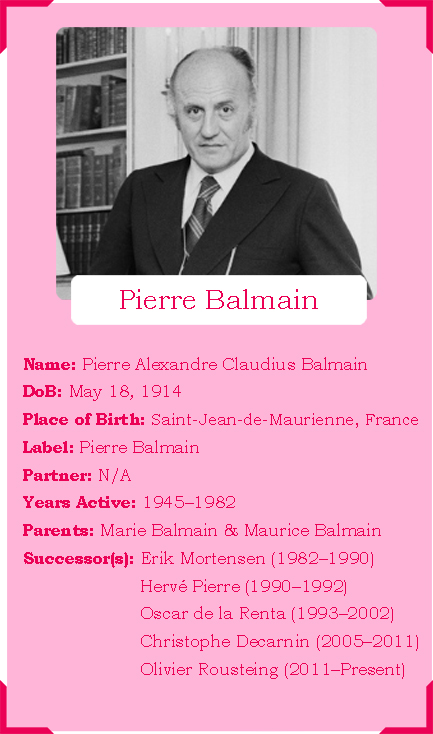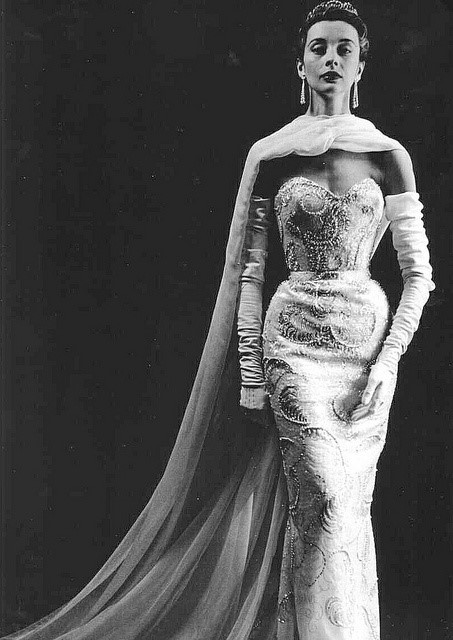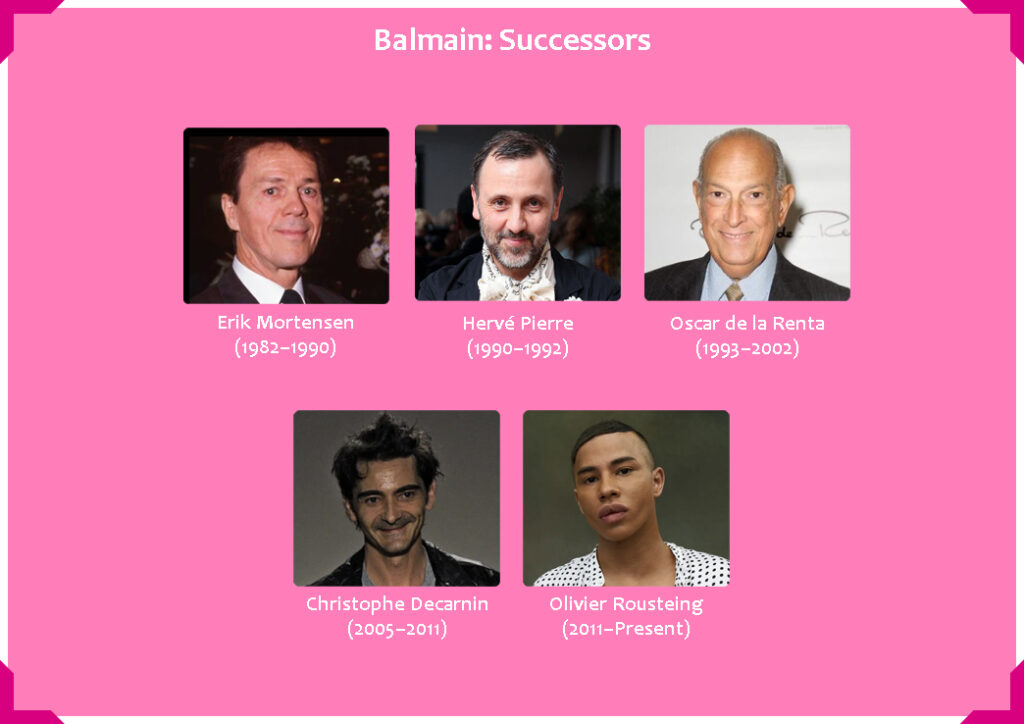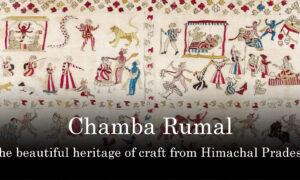Introduction to Pierre Balmain

Among the great of the French fashion pillars, there are few names that are as stellar as Pierre Balmain. He was a French fashion designer renowned for his sophisticated and elegant designs that exuded opulence and charm. His impact on the fashion industry can be defined by his signature style that embraced glamour, refined silhouettes, and intricate detailing. Known for saying,
“Dressmaking is the architecture of movement,”
Pierre’s designs were often described as architectural in their structure, blending form and function seamlessly. His work not only dressed the world’s elite but also set new standards in haute couture, influencing fashion trends for decades. Let us dice deep into the life and legacy of this great designer and look at his creations and philosophies that have made this fashion house the symbol of high fashion.
Early Life and Background
Pierre Alexandre Claudius Balmain was born on May 18, 1914, in Saint-Jean-de-Maurienne, a small town in the Savoie region of France. Raised by a dressmaker mother and an entrepreneur father, Pierre was exposed to textiles and design from an early age. His mother’s boutique served as his first window into the world of fashion, where he developed an affinity for fabrics and colors.
Pierre’s upbringing was filled with creativity and artistic inspiration, stemming from his mother’s work. The young Balmain was also influenced by his father’s architectural background, which later translated into his approach to fashion design. This dual exposure to the worlds of commerce and artistry would shape his future in haute couture, inspiring his meticulous attention to the structure and form of his designs.
Balmain studied architecture at the École des Beaux-Arts in Paris but soon realized that fashion was his true calling. After leaving the architectural program, he began working for established designers like Edward Molyneux and Lucien Lelong, where he gained valuable experience in dressmaking and design.
Career Beginnings
Balmain’s first foray into fashion was through an apprenticeship under Molyneux, a prominent British designer based in Paris. He worked there for five years before joining Lucien Lelong’s fashion house in the late 1930s. During his time at Lelong, Pierre had the opportunity to work alongside other future fashion legends, including Christian Dior.
In 1945, at the age of 31, Pierre Balmain established his eponymous fashion house in Paris, debuting his first collection to immediate acclaim. His “Jolie Madame” collection, characterized by its emphasis on femininity and elegance, captured the attention of critics and clients alike. The collection featured sleek silhouettes, nipped waists, and full skirts, all hallmarks of the post-war fashion that celebrated a return to opulence.
“A couture house should be a house of dreams, and that’s what I have sought to make Balmain.”
-Pierre Balmain
Despite initial financial constraints, Pierre’s dedication to his craft and his distinctive style quickly earned him a place among Paris’s fashion elite. His early years saw him catering to European royalty and Hollywood stars, cementing his reputation as a purveyor of luxury and sophistication.
Rise to Fame

Balmain’s rise to fame can be attributed to his exquisite craftsmanship and ability to design clothes that exuded effortless glamour. His post-war designs, particularly the “New French Style” that championed a tailored yet romantic aesthetic, became his trademark. In 1951, he made history by being one of the first designers to venture into ready-to-wear with his “Pierre Balmain Boutique” line, expanding his reach to a broader audience.
Throughout his career, he has collaborated with numerous high-profile clients, including film stars such as Ava Gardner and Marlene Dietrich. His close friendship with actress Gertrude Lawrence led to a collaboration where he designed costumes for her Broadway shows. His work in film, particularly his costume designs for movies like “And God Created Woman” starring Brigitte Bardot, further showcased his versatility.
Balmain’s contributions to fashion were widely recognized. He received the prestigious Légion d’Honneur in 1962, a testament to his influence on French fashion and culture. His fashion house continued to be a prominent force, even after his passing in 1982, under the creative leadership of designers like Oscar de la Renta and later Olivier Rousteing.
Signature Style and Innovations
Balmain’s signature style can be described as structured yet romantic, often featuring intricate embroidery, luxurious fabrics, and a focus on clean lines and silhouettes. His designs were characterized by a harmony of structure and softness, often drawing comparisons to architecture for their precise tailoring and sculptural elements.

Balmain is credited with pioneering the post-war “New Look” alongside contemporaries like Christian Dior. His approach was distinctive in its celebration of femininity without sacrificing practicality. His use of elaborate embellishments, such as beading and embroidery, set new standards in haute couture. He was also one of the first designers to introduce the concept of the “total look”—complete ensembles that included coordinated hats, shoes, and accessories.
The “Jolie Madame” collection of 1947 remains one of his most iconic contributions to fashion, showcasing a refined silhouette that became synonymous with Parisian chic. Balmain’s designs for Ava Gardner’s wardrobe in the film “The Barefoot Contessa” and his collaboration with costume designer Marcel Escoffier in “Let’s Make Love” further solidified his reputation as a master couturier.
Impact on the Fashion Industry
Pierre Balmain’s influence extended beyond his lifetime, shaping the work of future designers like Oscar de la Renta, who took over the fashion house in 1993. His meticulous attention to structure and fabric manipulation has inspired generations of designers, while his emphasis on elegance and femininity set the standard for haute couture.
Balmain’s runway shows were grand affairs that attracted the elite of Parisian society and international fashion aficionados. He was known for his attention to detail, not only in his designs but also in the presentation, setting new standards for fashion show production.
Balmain’s work reflected the changing dynamics of post-war society, embracing both the return to tradition and the desire for a modern identity. His designs for the likes of Katharine Hepburn and Queen Sirikit of Thailand showcased his ability to navigate different cultural contexts with grace and style.
“I think elegance isn’t solely defined by what you wear. It’s how you carry yourself, how you speak, what you read.”
-Pierre Balmain
Notable Collaborations and Projects
Balmain collaborated with numerous luxury brands, and his work in costume design brought his creations to the silver screen. His collaborations often transcended fashion, merging art and culture, as seen in his partnerships with international clients and film projects.
Balmain’s involvement in designing costumes for theatrical productions and films demonstrated his versatility. His work in Hollywood, particularly with Sophia Loren and Josephine Baker, remains legendary for its glamour and sophistication.

Personal Life and Public Persona
Pierre Balmain was known for his reserved and private nature, despite the glamorous circles he frequented. He never married, and much of his personal life remained out of the public eye. He was dedicated to his craft, viewing his designs as a means of expression rather than just fashion.
Legacy and Continuing Influence
Balmain’s legacy lives on through the continued success of his fashion house. Under the current creative direction of Olivier Rousteing, Balmain has been redefined for a modern audience while staying true to Pierre’s original vision of elegance and sophistication. The brand now boasts a global presence, with annual revenues exceeding 120 million euros.
Successors of the House of Balmain
The House of Balmain, founded by Pierre Balmain in 1945, has maintained its prestigious reputation through the decades, thanks to the leadership of several talented creative directors. These successors each brought their unique vision to the brand, evolving the fashion house while respecting Pierre Balmain’s original vision of opulence, sophistication, and structure. From Erik Mortensen’s classical couture to Olivier Rousteing’s modern and inclusive approach, the Balmain brand has flourished under various creative directions.
Erik Mortensen (1982–1990): Erik Mortensen, often referred to as Pierre Balmain’s “right-hand man,” was the first creative director to take over the house after Balmain’s death in 1982. Mortensen, a Danish designer, had worked closely with Balmain for over 30 years, making him a natural successor. He stayed true to Balmain’s vision of architectural tailoring and elegance, but also introduced his own sense of refinement and detail.
Under Mortensen’s guidance, the house continued to thrive in haute couture, maintaining its position as one of the leading Parisian fashion houses. He was awarded two prestigious Golden Thimble Awards (Dé d’Or), in 1983 and 1987, for his outstanding couture collections. His designs were characterized by luxurious fabrics, elaborate embroidery, and sophisticated silhouettes that upheld the haute couture tradition. Despite his success, Mortensen’s time at Balmain came to an end in 1990 when he left the house to pursue other ventures. His departure marked a turning point, as the house began to explore new creative directions.
Hervé Pierre (1990–1992): After Erik Mortensen’s departure, Hervé Pierre was appointed as the creative director of the house. Pierre, a young and promising designer, brought a fresh perspective to Balmain. His time at the house was relatively short but significant.
He introduced contemporary elements to the classic Balmain style, experimenting with modern fabrics and bolder cuts. His collections were well-received by critics, who praised his ability to merge tradition with modernity. Hervé Pierre’s tenure was brief, and he left the house in 1992. Although his time at Balmain was short-lived, his contributions set the stage for a new era of design.
Oscar de la Renta (1993–2002): One of the most prominent designers to lead the House of Balmain after Pierre Balmain was Oscar de la Renta. The Dominican-American designer joined the house in 1993 as the first non-French creative director. De la Renta, known for his romantic and feminine designs, brought an international flair to the brand.
He revitalized the house by blending his signature style with Balmain’s legacy of elegance and grandeur. His collections were praised for their refinement, luxurious materials, and intricate detailing, which attracted both old and new clientele. During his tenure, Balmain regained its stature as a leading haute couture house, particularly among European and American clients. Oscar de la Renta’s departure in 2002 marked the end of an era. He returned to focus on his own brand, leaving Balmain in need of a new creative direction once again.
Christophe Decarnin (2005–2011): Christophe Decarnin took over the reins at Balmain in 2005, and his arrival brought a dramatic shift in the house’s aesthetic. Known for his rock-and-roll sensibility, Decarnin introduced a bold, modern look that contrasted sharply with the classic couture of his predecessors.
Decarnin’s designs were characterized by sharp shoulders, body-hugging silhouettes, and heavy embellishments, which quickly gained a cult following. He introduced the “Balmainia” phenomenon, making the brand a favorite among celebrities like Beyoncé, Rihanna, and Kate Moss. Under Decarnin’s leadership, business revenue skyrocketed as the brand became a pioneer in merging high fashion with streetwear influences. However, Decarnin’s time at Balmain ended abruptly in 2011 due to health concerns. His departure left a void, but also set the stage for the entry of a new visionary.
Olivier Rousteing (2011–Present): Olivier Rousteing, who joined the house in 2011 at the age of 25, became one of the youngest creative directors in the history of fashion. Rousteing brought a contemporary, inclusive vision to Balmain, making the brand more accessible and relevant to a younger generation.
Rousteing’s collections are known for their opulent and heavily embellished designs, body-conscious silhouettes, and celebration of diversity. He played a key role in expanding the brand’s social media presence, building the “Balmain Army,” a group of celebrity advocates and influencers who embody the brand’s ethos. Under his leadership, the brand launched its first ready-to-wear collection for men and collaborated with global brands like H&M, which brought the brand unprecedented visibility. Rousteing also introduced the first-ever couture collection for the house in over 16 years, marking the house’s return to its haute couture roots.
Rousteing has been instrumental in making Balmain a globally recognized brand, with a younger and more diverse audience. His leadership has solidified the house’s position as both a traditional and modern powerhouse in the fashion industry.

Conclusion
The House of Balmain, since its inception in 1945, has evolved significantly through the vision and creativity of its talented successors. Each creative director who followed Pierre Balmain brought with them a distinctive style and perspective, leaving an indelible mark on the brand’s legacy. From Erik Mortensen’s seamless continuation of Balmain’s structured elegance to Olivier Rousteing’s bold reimagining of the house’s identity for a global audience, the fashion house has adapted to changing times while maintaining its commitment to opulence, craftsmanship, and sophistication.
Erik Mortensen, who worked closely with Pierre Balmain for decades, was more than just a successor; he was a torchbearer of the founder’s vision. His deep understanding of the brand’s DNA allowed him to carry forward Balmain’s ideals of impeccable tailoring and timeless elegance. Mortensen’s tenure ensured that the transition after Balmain’s death was not only smooth but also successful. He preserved the classic aesthetic while introducing his own nuances, setting the stage for Balmain’s continued dominance in haute couture.
When Hervé Pierre took over, his relatively short stint brought a fresh, youthful energy to the house, keeping it relevant in an industry that was beginning to embrace modernity and change. Although his tenure was brief, Pierre’s influence was pivotal, introducing contemporary elements that signaled the house’s willingness to evolve beyond its established identity.
Oscar de la Renta’s entry into the House of Balmain marked the first time a non-French designer took the helm of this Parisian institution. His romantic and feminine designs resonated with the house’s clientele, and his ability to combine his signature style with Balmain’s architectural elegance revitalized the house. De la Renta’s decade-long leadership brought international acclaim, making Balmain a beloved name among both European aristocracy and American high society.
The dramatic shift under Christophe Decarnin’s leadership in the early 2000s was a testament to Balmain’s adaptability. Decarnin’s rock-and-roll, glam-punk aesthetic transformed the brand into a symbol of edgy sophistication and helped it transition from an old-guard couture house to a contemporary fashion powerhouse. His influence in redefining luxury streetwear and introducing a daring new identity for Balmain made it one of the most sought-after brands of the decade.
The appointment of Olivier Rousteing in 2011 was a turning point that blended the traditional and modern eras of the brand. Rousteing’s tenure has been defined by inclusivity, diversity, and a deep connection to pop culture. He has successfully navigated the brand into the digital age, leveraging social media and the influence of celebrities to build a global “Balmain Army.” His bold and innovative designs celebrate diversity, empowering women and men alike with striking silhouettes, rich textures, and daring embellishments. Through his leadership, the brand has not only stayed true to its heritage but has also expanded its presence and appeal to a younger, more diverse audience.
Today, Balmain stands as a perfect blend of its storied past and its dynamic present. Each successor has respected the founder’s original vision while pushing the house into new territories, ensuring that it remains at the forefront of fashion. The brand’s continued success is a testament to its ability to innovate while preserving its core values of elegance, luxury, and craftsmanship. Balmain’s journey, from the ateliers of post-war Paris to its current status as a global fashion powerhouse, is a story of resilience, adaptability, and the enduring power of creative vision.
The House of Balmain continues to thrive under Olivier Rousteing’s leadership, with new milestones being reached each year. The brand’s return to haute couture under Rousteing, after a hiatus of over 16 years, reflects its commitment to balancing heritage with modernity. This return not only honors the house’s legacy but also paves the way for the future. The brand’s ability to maintain relevance across generations is a testament to the strong foundation laid by Pierre Balmain and the exceptional stewardship of his successors.
As we look to the future, the House of Balmain remains a beacon of luxury and innovation, inspiring new generations of designers and fashion enthusiasts. The designer’s journey, with its illustrious past and promising future, continues to be written, proving that true elegance and creativity are timeless. I hope you have enjoyed reading this little tribute to this legend of a man. Please share your favourite moment from the house of Balmain and let me know if I have missed any aspect of this great pioneer’s life.




























